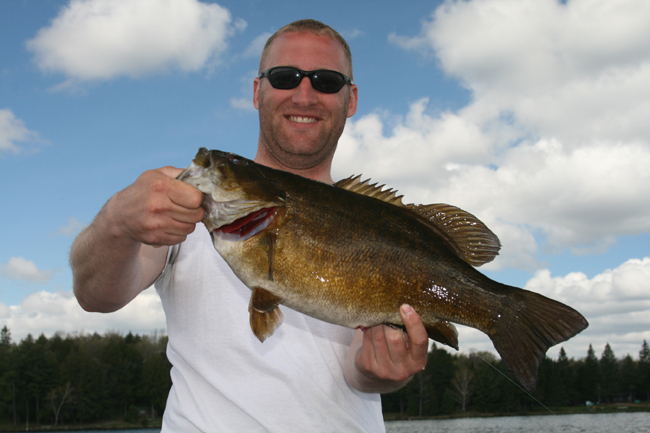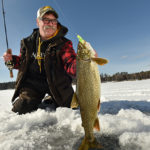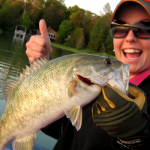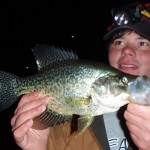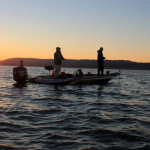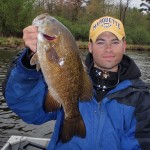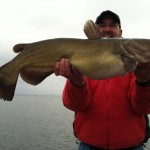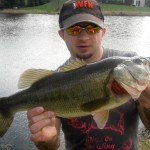By: Andrew Ragas
The spring fishing season and its weather inconsistencies often resembles the shape of a roller coaster that is full of inclines and declines. For instance, there are periods of warmth which lead to good fishing, periods of cold which lead to miserable fishing, and never a consistent happy medium that is somewhere in between that represents satisfactory fishing. Record the results in the form of a bar graph and you will see what I am talking about.
Spring weather stinks. It’s rare to have a weather-perfect spring fishing season.
When it comes to locating and catching shallow water smallmouth bass from our natural lakes, cold weather that prevents warming water temperatures and stalls the early season movements and shallow water spawning of fish often bewilders anglers. This happens all too frequently in our northern waters of Wisconsin, Minnesota, Michigan, the Great Lakes, and Ontario, Canada.

Unless you are fishing a warm spring paradise, in which consistently warm weather lasting several days leads to easy fish predictability and their presence in shallow water, big spring smallmouth bass are otherwise difficult to find, and sometimes harder to entice. Last May, for example, my fishing partner and I had experienced this dilemma on a favorite trophy smallmouth lake of ours in Northern Wisconsin.
Unlike previous spring seasons during the months of May and early June, in which the days get warmer and the fishing is usually excellent, the entire 2011 spring season was an extremely difficult period for several bass anglers including ourselves. A cold winter season in the North Country had extended itself into early May, resulting in a late ice-out and cold season opener. Consequently, this gave way to a very cold and unusual spring catch and release bass season.
It was the third week of May. According to my yearly trip records and catch statistics, the second week of May until the first week of June for the north is traditionally the best time of the year to catch and release the largest bass of the entire season from hundreds of lakes. The particular lake we fished is a large, 1,000-plus acre lake with deep, clear water. It is often overlooked for its excellent numbers of smallmouth bass in the three to six pound range.
During a normal spring, trophy smallmouth bass by the dozens depart their wintering areas and head to the lake’s shallow bays and spawning flats. To date, our most successful method of fishing this venue during spring in the pre and post spawn periods is by employing sight fishing tactics in its shallow clear water with soft plastic stickbaits and craw imitators. This practice is deadly, and probably should be illegal when the majority of the lake’s smallmouth population invades the shallows for spawn. But unfortunately, this was not the case during our outing as the unexpected was encountered.
In over 90 minutes of patrolling the lake’s known spawning flats and shallow springtime smallmouth locations, fish were nowhere to be found. What my fishing partner and I had on our hands was a problem.
Water temperatures were only a brisk 48 to 51 degrees, a full ten degrees below normal for this particular time of year. Forgetting the fact that it was warm and sunny out, the epic shallow water bites from previous years would be unthinkable to occur on days like this.
What to do next was our initial thought. When in doubt, allow your instincts and boat’s electronics to take over and dictate your next plan of attack. If fish aren’t found shallow, then they will be found deep, or somewhere in between as we quickly found out.
When shallow fails, look deeper
We motored across the lake to a known main lake spawning flat with a nearby wintering area, the lake’s largest. We then concentrated on the deep water surrounding the shallow flat by using our electronics.
This specific area was a long, shallow rock bar that extended 50 yards out from a main lake point. Its shallowest water was two feet deep, and its edges gradually dropped off into multiple ledges: The first a primary ledge with rocks at 15 feet, and the secondary ledge with gravel at 25 feet before bottoming out into the wintering hole with mud at 45 feet. This is a classic area for holding cold water fish.
I put aside my shallow water finesse equipment in favor of the big guns. A seven foot, four inch medium heavy Quantum Superlite rod and Energy reel spooled with 8lb line and a fluorocarbon leader. A seven foot medium heavy rod with 8lb line is standard fare for my tube fishing. Rigged was a 4 inch Stankx Bait Company tube in “purple haze” color with a 3/16 oz. Owner Wide Gap tube insert. I told my partner to dig through my tube box to experiment with colors and for him to do the exact same. “Trust me on this one, for we have nothing to lose,” I said. Keep in mind this is something I have never tried on this lake before, but a technique I had confidence in. He rigged up with a pumpkin/red fleck tube of the same brand. With the boat parked near the secondary shelf at the 25 foot level, with precise boat control aided by the trolling motor, I flung my tube out just beyond the 15 foot primary shelf where it landed near the shallow rocks.
As it landed, I let the tube jig sit lifeless. I waited several seconds before slowly dragging it down towards the first shelf, rotating my reel about once every ten seconds. It was painful for me to stay patient, but it would eventually pay off. As the tube crawled ten feet deeper from first shelf to the second, mister smallmouth gobbled it up. I felt weight and set the hook.

From the depths and to the boat came a four pounder. A renewed sense of confidence had infected our boat, and the patience was finally paying off. Moments later, I set the hook on another fish, a similar sized three and a half pounder. The games were just beginning, and a pattern was happily coming to form.

My partner, an observant angler without much experience fishing deep water with tubes, had followed my lead and finally hooked himself into a whale of a smallmouth.
As he slowly played the fish up from 25 feet down, two anglers in a bass boat slowly idled their way past us, observing his fight. As the 21 inch smallmouth came into the net, the frustrated driver of the boat looked on, and yelled, “Any idea where the fish are at? I cannot believe we’re not finding them shallow. At this time last year, the shallows were all loaded!”

I could tell they were desperately struggling. “Go deeper,” I responded. It only made sense because the water was still too cold for any shallow water fishing as we obviously found out.
For the remainder of the outing, my partner and I fished the drop-offs and ledges of other similar main lake flats with nearby wintering holes. Another half dozen sizeable pre-spawn smallmouth bass in the three to four pound range were caught before our satisfying conclusion.
Tube Tricks

Fishing bottom oriented baits for smallmouth bass is an often overlooked spring tactic. Anglers usually turn to the fast, reactionary strike approach of jerkbaits, crankbaits, and spinnerbaits before rapidly slowing down the pace to meticulously fish with plastics such as the tube. Often times, during the cold misery of spring, anglers fail to slow themselves to the pace of cold water smallmouths. I have been guilty of this crime several times. But luckily I came to my senses to find out the tube jig is a perfect choice for this, especially when fish are beginning to transition, and water temperatures are below 55 degrees.
Consistency with early season bass requires knowledge with a wide variety of presentations. The classic tube jig is one of them. It’s no secret that tube jigs are popular choices for smallmouth bass. The reason for this lies in the fact that crayfish are favorite natural forage species, as are gobies and other bottom dwelling prey fish which tubes also represent.
During these prolonged cold spring conditions, the term of “fishing too slow” does not apply. With tube jigs, you want to fish them as slow and meticulously as humanly possible.

During the early spring, the secret is to fish tubes as slowly as possible, to dead stick periodically, and to keep bottom contact at all times. Give the tube a twitch and hop every now and then, but maintaining bottom contact is most important. I often employ the dragging retrieve, which most closely resembles the behavior of a live crayfish that is scurrying along the bottom. When working the drop-offs of a shallow spawning flat and its nearby deep water, patience will be taken to the limit and tested.
Tubes make so much sense in these deeper cold water conditions. It’s a perfect storm because as smallmouths are transitioning from the wintering depths to the shallow water of the flat, crayfish also follow suit. Anything resembling crayfish is a guaranteed meal for smallmouth bass, and tubes are the ideal representation. Best of all, they can be worked at all depths.
Regardless of your retrieve and manner of jigging, it is extremely important to pay close attention to your line for any movement or hits, and the rod tip for feeling out the bottom and all of its cavities and crevices between rocks and gravel. In my experience, smallmouth bass can spit out a tube just as quickly as they suck them up. Thus concentration, patience, and fast reflexes with a strong hook set are crucial for success.

Tube Styles and Rigging
Tubes are available in a number of sizes, styles, and vast array of colors. They may be rigged in several ways such as Texas rigged, weightless, or with an insert style jig head which is my preferred method for all scenarios.
The insert style jig head is the most ideal rig method for most situations. For deeper water fishing, it is the best and most trusted method I’ve found. Popular jig brands for tube inserts are Bite Me Vertical Eye Tube Jigs (available with rattles and without), and Owner Jigs tube inserts which feature a wide gap hook and maximum hook point exposure. Within the last year, I’ve added a new jig brand to the arsenal, and they are KustomKicker Jigs, a new favorite of mine. Produced by a small independent manufacturer in Northern Michigan, they are quite possibly the strongest, sharpest, and most unbreakable surgically sharpened hooks I’ve ever used.
When inserting the jig into tube body, the narrow head of the jig is completely pushed up against the head of the tube, through the hollow body of the bait. When inserted, the eye of the jig is then pushed through the head of the tube where you may tie directly to the tube.
As far as jig sizes are concerned, I base my weights according to tube size/thickness, and depths I am fishing. Since salt impregnation is standard on the tubes produced by most companies (Strike King, Venom, YUM), extra weight is added, which improves sinking rate. Almost always, I can get away with using the lightest jigs possible. I often use jig inserts weighing anywhere from 1/8 oz to ¼ oz as most depths can be successfully covered from the shallow spawning flat, along the drop-off and ledges, all the way down to the winter hole.

If you perform a Google search for “tube jigs,” your search results will be littered and polluted by dozens of brands, and hundreds of styles. To some anglers, the style and design of a tube might not make any difference. But to me, tubes have a lot of differences and there are some factors that separate good tubes from just ordinary tubes.

What I look for in a quality smallmouth tube is its plastic formula, its level of salt and additive impregnation, availability of colors and attention to detail, and durability. A few brands meet all these requirements for my preferred tubes, and they are made by Strike King, YUM, and Stankx Bait Company. In my opinion, color seems to have less of an impact or significance than the size, profile, and scent of the tube.

Conclusion
Tube jigs are a match made in heaven for smallmouths. Perfectly representing the preferred choice of crayfish and other bottom dwelling prey, the tube jig has been catching smallmouth bass for a number of years. Finally, after learning the hard way, tubes have made their way into my arsenal for successful early season smallmouth fishing.
When it comes to fishing for smallmouth bass during the cold misery of spring, don’t make the frequently common mistake of relying on shallow water spawning flats as I have, and other anglers do. If fish aren’t present, and springtime water temperatures are colder than usual for the particular date, alter your approach and allow your instincts and boat’s technology to take over and dictate your next plan. There is no reason to be stubborn if fish aren’t around.
Remember, if shallow water futilities are experienced during the anticipated time when smallmouths are supposed to be shallow, don’t give up at that point. The fish are to be found somewhere in the lake. At this point, there is nowhere else for you to go but to look deeper. By fishing deeper, and slowly to the point that patience is tested, there is not a more effective cold water spring strategy than employing the tube jig along the spawning flats their nearby wintering holes of smallmouth bass.



